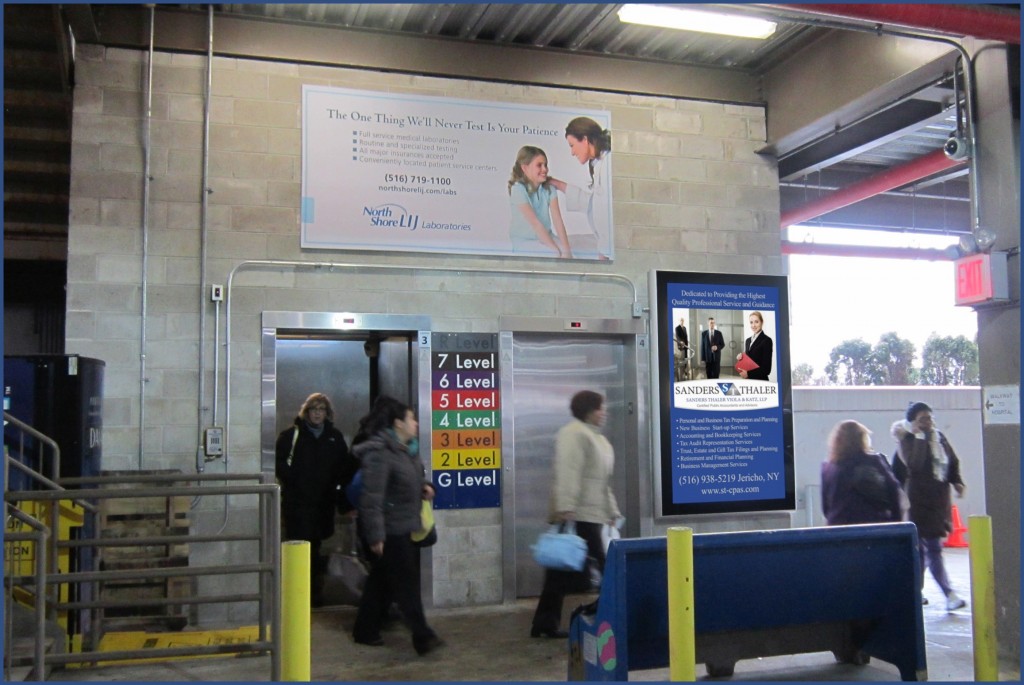Long Island Business News (Nov. 1-7, 2013 / VOL. 60 / NO. 47) – Posters pitching products are common in airport terminals, as are rotating signs selling services at the mall.

But advertisements inside hospitals?
Health-care facilities have historically adopted more somber tones, but many are changing that tune as advertisers warm up to hospital employees, patients and visitors, and facility managers recognize new revenue opportunities.
The fabled Mayo Clinic runs ads for myriad medications on its website, for instance, but no Long Island facility has yet embraced digital advertising or promos for particular drugs. There are still questions of appropriateness – and some lines local hospitals haven’t crossed.
“We can’t appear as if we’re endorsing specific medical products,” said Winthrop-University Hospital Vice President J. Edmund Keating, “because we’re not.”
But with advertisers expressing interest and hospitals hungry for revenue, companies like Summit, N.J.-based Innovare Medical Media – which has installed billboards and scrolling signs at several Long Island hospitals – are wading into the market, Innovare Partner Michael Ricciardi said.
It isn’t easy overcoming the notion that hospitals are places where the sick come to heal – or not – and therefore ill-suited to for-profit commercialization.
“Some hospitals are more aggressive and some are more reserved,” Ricciardi said. “Each hospital has its own entrepreneurial way.”
But Innovare is still finding plenty of Long Island business. The North Shore-Long Island Jewish Health System worked with the New Jersey marketing company to install fixed and alternating signage at North Shore University Hospital in Manhasset and Long Island Jewish Medical Center in New Hyde Park, while Mineola’s Winthrop has also installed Innovare signage in common areas including parking garages, cafeterias, elevators and waiting rooms.
 Among those pitching hospital audiences are several local institutions of higher education, including St. Joseph’s College and Adelphi and Long Island universities. Auto dealers such as Westbury’s Rallye BMW and Great Neck’s Beiner Audi also advertise in hospitals, as does the occasional assisted-living facility, including Sun Harbor Manor of Roslyn Heights.
Among those pitching hospital audiences are several local institutions of higher education, including St. Joseph’s College and Adelphi and Long Island universities. Auto dealers such as Westbury’s Rallye BMW and Great Neck’s Beiner Audi also advertise in hospitals, as does the occasional assisted-living facility, including Sun Harbor Manor of Roslyn Heights.
“It’s a new opportunity to reach an outstanding demographic audience of health-care professionals and the community at large,” said Diane Moser, Adelphi’s executive director for marketing.
By aligning the Adelphi brand with regional hospitals, the university positions itself as a regional leader in health-related education – a worthy investment, Moser added.
But insiders like Winthrop Chief Operating Officer Garry Schwall are quick to note that revenues from advertisers like Adelphi aren’t the only benefits for the hospitals.
Schwall is happy to have the new source of revenue, he said, but hospitals can also use professional billboards and scrolling signs to deliver their own marketing messages.
“We were able to brighten up walkways and get some of our marketing messages up at the same time,” he said. “The revenue generation was a much less significant consideration.”
So Winthrop can promote specific cardiology or orthopedic services, for instance, along with impressive rankings from the likes of U.S. News and World Report. And when it does permit outside advertising, it’s careful not to concentrate too much on a particular industry, or to tip too far onto the for-profit side.
“I wanted balance,” Keating said. “I wanted a limited number of any one type of advertiser, including nursing homes. It was first-come, first-served, and after that, we said ‘it’s enough.’”
That’s not to say there isn’t profit to be had. Winthrop’s new advertising opportunities should produce $2 million in revenues during the next decade, Ricciardi said, with an unspecified percentage going to the hospital.
Advertisers see hospital crowds as “a good target audience – a high-value audience with a good household income,” Ricciardi noted.
And they’re willing to pay to reach that audience, even if many of the hospitals – while welcoming new revenue streams – aren’t out to make a killing.
North Shore-LIJ spokesman Terry Lynam said the system sells advertising opportunities primarily in spaces like parking garages, “the same way we sell ads in our publications and patient guides to cover the cost of production.”
And while being careful not to “overwhelm our patients” with blaring advertisements, facilities like those throughout the North Shore-LIJ system are also very selective about whom, exactly, can advertise on their grounds. Hospital A is not likely to run an ad promoting Hospital B, for instance.
“As much as we want the revenue to help offset some of our expenses,” Lynam noted, “we don’t want to steer customers to our competitors.”
Based on that natural selectivity and other sensitivity guidelines, there’s still plenty of advertising space to go around.
Innovare has been steadily adding hospitals to its mix since 2010, when its founders sold InterSpace Airport Advertising, which marketed in over 200 global airports, to Clear Channel Outdoor. Citing better demographics and a less-transient audience, Innovare has now installed signage in more than a dozen health-care facilities and plans to be in about 100 by 2018.
While more hospitals recognize the potential, Ricciardi agreed with Lynam that they’re going to be very careful about the clients they let advertise in their parking lots and waiting rooms. Innovare owns the signs, but the hospitals have final approval on advertisers and how their messages are delivered.
Ultimately, there’s a matter of decorum – and health-care facilities aren’t likely to run ads for tobacco or alcohol products or anything that might be considered in poor taste.
“It’s an opportunity for businesses to reach a good marketing demographic,” Ricciardi said. “But you’re not going to see ads for a funeral home or malpractice attorneys, and you won’t see retail advertising.”
http://libn.com/2013/11/01/healthy-signs-for-hospitals/
Written by: Claude Solnik
Published: November 1, 2013
